





SAN FRANCISCO SPECIALTIES

SPECIES OF INTEREST
- Red-throated Loon
- From October to March they should be found in the water near shore from Fort Funston north to Land's End, then along the Bay shore east to Fort Mason, inside the Golden Gate. Often most plentiful loon in S. F. waters. During spring and fall migrations can be seen moving in sizeable flocks along western edge of S. F.
- Pacific Loon
- From September to March can often be seen offshore along western edge of San Francisco. Rare east of Land's End. Best vantage point is from the hang glider launch overlook at Fort Funston.
- Red-necked Grebe
- One or more individuals can sometimes be found in the usual wintering flock of Western Grebes found east or north of Fort Point. May also appear in the flocks of migrating Aechmophorus grebes migrating along the coast. Not likely east of Crissy Field. If present in San Francisco would likely get mentioned on local Rare Bird Alert (415-681-7422).
- Western Grebe
- Plentiful in flocks from October through April. Sometimes mixed with a few Clark's Grebes. A few individuals can sometimes be found east of Fort Point at any time of year. At this same point the winter flock often numbers over two hundred. Can also be expected along shoreline from Fort Mason west to Cliff House during winter. Often found on Lake Merced during winter.
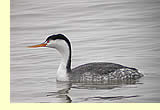 Clark's Grebe
Clark's Grebe- May turn up in almost any flock of Westerns. Most dependably found in small group in northwest corner of northern section of Lake Merced. Wintering season is late October through March. In recent summer one pair has nested at southwest corner of Lake Merced.
- Sooty Shearwater
- Begins to appear offshore along Ocean Beach at end of June. Erratic. Most years numbers build until this is the most plentiful bird visible in San Francisco on some days in August and September. Usually gone by end of the year. This shearwater breeds in Southern Hemisphere, then comes up here for the Austral winter. Look for large, dark, swirling flocks numbering many thousands of birds. Usually several hundred yards offshore at minimum. Not expected inside the Golden Gate. Sooty swarms often attract hundreds of pelicans, cormorants, gulls and alcids. Not seen over land or fresh water.
- Black-vented Shearwater
- This shearwater breeds just a few hundred miles away off Baja California. Appears here in modest numbers from September through December. Usually seen as tiny fraction of the huge Sooty swarms offshore. Most numerous here when surface waters are warmer than usual (El Nino years).
- Brandt's Cormorant
- A local breeder. Usually on Seal Rocks off the Cliff House. Can show up anywhere offshore along Ocean Beach east to Golden Gate Bridge. Occasionally seen offshore inside Bay, e.g. Coast Guard Pier at Crissy Field. Not expected over land or fresh water.
- Pelagic Cormorant
- Breeds in colonies north and south of San Francisco and on Alcatraz and Farallone Islands. Normally seen as individuals or small groups at Cliff House, Fort Point or other points overlooking open water. Occasionally perches on offshore buoy or pier. Not found on fresh water or over land.
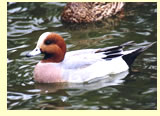 Eurasian Wigeon
Eurasian Wigeon- Some years one winters in San Francisco, most often on one of the ponds in Golden Gate Park. The Northern California Rare Bird Alert (415-681-7422) would note its presence if one is found.
- Tufted Duck
 In some winters there will be a wayward Tufted Duck among the Scaup and Canvasback on Spreckels Lake in Golden Gate Park. If a Tufted turns up anywhere in San Francisco, it'll be noted repeatedly on the Rare Bird Alert (415-681-7422).
In some winters there will be a wayward Tufted Duck among the Scaup and Canvasback on Spreckels Lake in Golden Gate Park. If a Tufted turns up anywhere in San Francisco, it'll be noted repeatedly on the Rare Bird Alert (415-681-7422).- Oldsquaw (Long-Tailed Duck)
- Regular winter resident in some parts of the Bay Area, occasional in San Francisco. Can occur among large flocks of sea ducks during migration. Would usually be noted on the Rare Bird Alert (415-681-7422).
- Black Scoter
- Usually a few winter near San Francisco shores every year. Usually in with flock of the abundant Surf Scoter. The overlook at the hang glider launch at Fort Funston is a good place to try from November to March.
- Surf Scoter
- An abundant winter resident all along the shore of San Francisco from Candlestick all the way around to Fort Funston. None of the scoters should be expected on ponds or lakes. A few may spend entire year off Fort Funston or Crissy Field. Large populations in San Francisco from November through March.
- White-winged Scoter
- Always a few individuals among the large Surf Scoter flocks. Candlestick Point and Fort Funston are two likely spots to look. Around in late fall and winter.
- Red-breasted Merganser
- Wintering bird found on Bay waters inside the Golden Gate. Crissy Field and Aquatic Park at the north end of Van Ness Avenue are two likely spots to try from November through March. Spring birds can be in breeding plumage just before they depart northward.
- Osprey
- They hunt regularly at Lake Merced in all seasons. A number of pairs nest in Marin County, north of San Francisco. Most nest sites are a few miles north from the Golden Gate Bridge. Occasionally in summer an Osprey can be seen flying northward clutching a fish. Not known to nest in San Francisco at this time.
- Merlin
- A regular winter resident in open and windy areas of city, and some residential areas. Frequents Candlestick Point, Sunset District and Richmond District. Arrives in late fall, leaves in March.
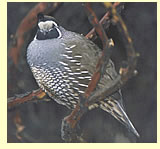 California Quail
California Quail- A precariously surviving breeder in San Francisco, locally threatened by feral cat population and natural predation. Largest covey is in Presidio, smaller populations in Strybing Arboretum, Golden Gate Park, at Fort Funston and McLaren Park. Presidio has special signs asking drivers to watch for quail. Non-migratory. In spring the calls are frequent and good guide to location.
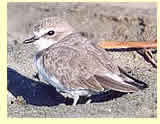 Snowy (Kentish) Plover
Snowy (Kentish) Plover- Only a handful spend the non-breeding season along Ocean Beach. This now-rare Northern California breeder likes open sandy beaches. Often found near flocks of larger Sanderlings or other wintering shorebirds. From July through February look along Ocean Beach near East end of Pacheco Boulveard, or simply walk the length of the beach.
- Black Oystercatcher
- A local breeder and non-migratory resident. One pair nests annually on one of the Seal Rocks. Other pairs breed along rugged cliffs between Land's End and China Beach. Loud screams are often first clue this bird's in flight. The parapet on west side of Cliff House is fine place to scope the offshore rocks. Occasionally seen onshore along water's edge or on the rocks beneath Cliff House or Land's End.
- Wandering Tattler
- These early migrants begin arriving at Cliff House and Land's End in July, usually at least one Tattler lingers until April. Often on the offshore Seal Rocks, or rocks just below Cliff House. Sometimes found with turnstone and Surfbird flocks.
- Long-billed Curlew
- Likes muddy shorelines. Found most often on Bay shore at Heron's Head Park (Pier 98) or Candlestick Point. Arrives in September, gone in March. While common in other parts of Bay Area, usually only a single bird seen in San Francisco.
- Black Turnstone
- Every winter there is a flock around the Seal Rocks and Land's End, though they are not always visible. Occasionally there are some at Candlestick Point and at Double Rock. They can begin arriving in July. Some are still around in early April. The flock will often include a Ruddy or two, plus wintering Surfbirds. Avoids open sand or mudflats.
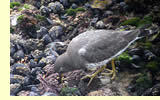 Surfbirds
Surfbirds- Often seen in turnstone flocks, arrives in September and stays around through March. Most likely spots are Land's End and Cliff House. Check both offshore and rocks directly below the viewing parapets in both places. Usually Surfbirds are in small flocks, not just a single bird. Not found on open sand or muddy areas.
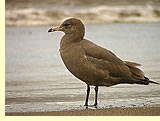 Heermann's Gull
Heermann's Gull- This bird breeds off the coast of Mexico. After breeding season it migrates northward, arriving in the Bay Area in July. By August this gull is abundant along the western and northern shorelines of San Francisco. Can usually be found along Ocean Beach in large numbers, also present around the Cliff House, Seal Rocks, Marina Green, Crissy Field. Not usually present in gull flocks found on fresh water.
- Mew [Common] Gull
- A small, wintering gull, expected from November through March. Flocks often found on North Lake and Spreckels Lake, Golden Gate Park, as well as the southeast corner of Lake Merced. Also, frequents Bay waters off Crissy Field. These small gulls ride high in the water with their bellies seeming to barely get wet.
- California Gull
- Breeds on inland waters of the Pacific Slope. A few individuals may be around all year. Can be found anywhere gulls congregate. Regular on Lake Merced in late fall and winter when the California Gull population at its peak. Most gone by April.
- Thayer's Gull
- This gull breeds far to the north. A few individuals arrive in the fall and may be found in gull flocks until March. Areas like the Cliff House, Stow Lake in Golden Gate Park and the south end of Lake Merced are best for trying to find the Thayer's in the gull flock because you can get closer looks.
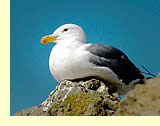 Western Gulls
Western Gulls- San Francisco's only breeding gull. Nests can be seen on Seal Rocks during June and July. Abundant year-round wherever you expect to find gulls: from beaches to picnic areas to parking lots.
- Glaucous-winged Gull
- These large gulls arrive in late fall, all but a rare few leave in early spring. They breed in the North Pacific area and during winter mix with the gull flocks around San Francisco. May be found around salt water or fresh water like Spreckels Lake in Golden Gate Park or Lake Merced. They seem to avoid smaller, more enclosed ponds.
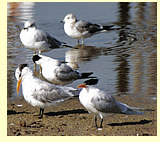 Caspian Tern
Caspian Tern- Most often seen fishing in ocean or Bay waters, may also fish at Lake Merced. They breed around the Bay, but migrate out in October, return in the spring. Juveniles from the Alameda colony may join parents in July and be seen feeding along Ocean Beach.
- Elegant Tern
- Part of the constellation of Mexican breeding species, along with Heermann's Gull and Brown Pelican. They come north from their breeding territory in July and are around in modest numbers from August until December. Then they migrate south. They fish over Bay and Pacific, not fresh water. They are highly mobile but check the Coast Guard pier off Crissy Field in August and September for chance at a close-up look. Also can be found resting on Ocean Beach. Usually hunt in small groups.
- Common Tern
- Regular but uncommon fall migrant. Best found on the Coast Guard pier at Crissy Field from late July until mid-September. There you can practice picking them out of the flock of more plentiful Forster's Terns. And maybe there'll be some Elegants for size comparison.
- Common Murre
- San Francisco's most plentiful Alcid. Hundreds breed on the Farallone Islands. Some feed near shore and can be seen on the water, or in flight, from April through September. Best viewing is from Cliff House or the parapet at Land's End. Can be in large flocks. Occasionally found inside the Golden Gate.
- Pigeon Guillemot
- A scarce but yearly summer breeder along the rocky coast of northwestern San Francisco. Most often found off Land's End or rocky shoreline east to Golden Gate Bridge. May be seen offshore at Crissy Field in summer. In S. F. the Guillemot is usually seen in small numbers. They leave shortly after Labor Day for unknown destination in the pelagic Pacific. Usually re-appear in April.
- Band-tailed Pigeon
- Has bred in San Francisco in recent past. Now seems to appear only during migration though few birds may over-winter. Prefers tall, mature evergreens. Best spots to look are Mount Davidson and Mountain Lake Park bordering the Presidio.
- White-throated Swift
- Colony breeds and lives year round at Candlestick Point in the sports stadium there. Can usually be seen with scope from the parking lot of the state park east of the stadium. May also breed under some overpasses and other large structures.
- Anna's Hummingbird
- This year-round resident may turn up in any brushy area. It is easier to find when the littler, aggressive Allen's Hummingbird is not around. In November and December the steep mating dive of the male Anna's is a spectacle to watch for. Good spots are north side of Lake Merced, Mount Davidson and Golden Gate Park's Strybing Arboretum.
- Allen's Hummingbird
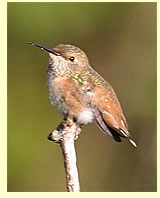 This tiny migrant is present from February through August. It is one of the earliest nesters each year, with a first egg clutch in the nest in March. The males have nothing to do with the nesting female or her nestlings. However, they display and perform aggressive territorial wars, often chasing birds many times larger. Highly vocal. Area where grassland meets forest on Mt. Davidson is good place to look, also the Strybing Arboretum , Golden Gate Park.
This tiny migrant is present from February through August. It is one of the earliest nesters each year, with a first egg clutch in the nest in March. The males have nothing to do with the nesting female or her nestlings. However, they display and perform aggressive territorial wars, often chasing birds many times larger. Highly vocal. Area where grassland meets forest on Mt. Davidson is good place to look, also the Strybing Arboretum , Golden Gate Park. - Olive-sided Flycatcher
- This migrant seems to be suffering from winter habitat loss in the tropics. Once common it is now an annual, but uncommon, breeder in San Francisco. Needs tall, mature trees. Often inconspicuous, but can frequently be found by ear from April through June when the "Quick-three-beers" call carries far from its treetop perch. Check forested areas of Golden Gate Park and Presidio (Kobbe & Upton for example). It is present in many gleaner flocks during spring and fall migrations.
- Pacific-slope Flycatcher
- Common migrant in wooded, brushy areas in spring and fall. At those times try the southwest corner of Middle Lake, Golden Gate Park, or East Wash near the Legion of Honor. Irregular nester in riparian and brushy habitat. Stays in the shade generally but can be heard calling through July. Occasionally breed in S. F. Present April through September.
- Black Phoebe
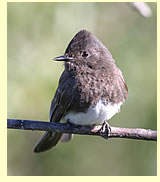 A common, hardy and aggressive resident flycatcher. Breeds in many locations in San Francisco. Builds mud-and-stick next in late March, usually has two broods per season. Seen only as single bird once young are fledged. Population increases in winter when mirgants arrive from northern part of range. Often quite conspicuous when feeding. Places to check: Crissy Field, north side of Lake Merced, west of the Bercut Equestrian Ring and around Stow Lake, both in Golden Gate Park.
A common, hardy and aggressive resident flycatcher. Breeds in many locations in San Francisco. Builds mud-and-stick next in late March, usually has two broods per season. Seen only as single bird once young are fledged. Population increases in winter when mirgants arrive from northern part of range. Often quite conspicuous when feeding. Places to check: Crissy Field, north side of Lake Merced, west of the Bercut Equestrian Ring and around Stow Lake, both in Golden Gate Park.- Say's Phoebe
- Another hardy flycatcher. Arrives in November from inland breeding territory and stays through March. Prefers open habitat. Most often found at Fort Funston, Crissy Field and other open parts of the Presidio, Candlestick Point. Not usually found in flocks of migrants.
- Hutton's Vireo
- A hardy, year-round resident. A frequent victim of the Brown-headed Cowbird so do not use recorded sounds to find this bird during breeding season. Nests in brushy areas of Golden Gate Park, McLaren Park and Presidio. Can be found in gleaner flocks in fall and winter.
- Cassin's Vireo
- A migrant that passes through San Francisco in spring and fall. Check gleaner flocks during August and September, again in April and early May. The Fuchsia Dell and Middle Lake in Golden Gate Park, East Wash and West Wash are best chance.
- Chestnut-backed Chickadee
- Vocal, hyperactive little resident. Joins mixed flocks in fall and winter. These gleaner flocks seem to coalesce around the local Chickadee and Pygmy Nuthatch. Flocks can numbers several hundred birds when the eucalyptus trees begin to bloom in winter. This chickadee be found in many parts of Golden Gate Park: Chain of Lakes, Stow Lake, Strybing Arboretum, also in McClaren Park, the Presidio and north side of Lake Merced. Often heard before seen. May respond to a timely "pish."
- Bushtit
- Highly gregarious. Our smallest non-hummingbird. Often joins the gleaner flocks in fall and winter. Seems to be half tail. Prefers dense brush beneath taller trees. Can often be spotted flitting across open area as a steady flow of little gray birds goes from one dense bush to another. Has a characteristic sound that comes from individuals within a flock. Found in brushy areas of Golden Gate Park, Presidio and hiking trail between Land's End and Legion of Honor. Also found at Lake Merced and McLaren Park.
- Pygmy Nuthatch
- A common, gregarious, vocal year-round resident. Easiest to find outside of breeding season when larger flocks form. Almost a gimme September-March if you spend any time standing beneath mature evergreens in Golden Gate Park, the Presidio or Land's End. The flock has a characteristic chatter as it moves through treetops. If a fresh limb or tree has fallen, these little birds will come down to the ground to feed. Found in most gleaner flocks during cold months.
- Swainson's Thrush
- A secretive bird that is possible to find in late spring when it is giving its haunting call. Try the east end of Mountain Lake during May or June. Found mostly near fresh water.
- Varied Thrush
- An irruptive migrant. Some winters it can be common in San Francisco, other years it is rare. Prefers dense, damp wooded areas. Sometimes found with American Robin flocks in wooded areas. Mt. Davidson, Golden Gate Park and the Presidio are good places to look, November - March. Local birders can tell you if it's a good year for Varied Thrush.
- Wrentit
- An abundant breeding bird in native coastal scrub north and south of San Francisco. Local birders would have best, most recent clues to the Wrentit's whereabouts. Not likely to be a breeding population left in San Francisco.
- Townsend's Warbler
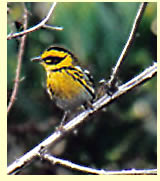 This brightly colored western warbler is present from September until April. Usually found in gleaner flocks, with a usual ratio of many dozen Yellow-rumped Warblers to each Townsend. The second most common warbler in every San Francisco Christmas Count. Prefers dense stands of trees, often congregates in the blooming eucalytpus groves in winter. Any park with tall trees should have a Townsend of two in season.
This brightly colored western warbler is present from September until April. Usually found in gleaner flocks, with a usual ratio of many dozen Yellow-rumped Warblers to each Townsend. The second most common warbler in every San Francisco Christmas Count. Prefers dense stands of trees, often congregates in the blooming eucalytpus groves in winter. Any park with tall trees should have a Townsend of two in season.- Hermit Warbler
- Regular, but never common fall and spring migrant. Usually high in trees as part of a gleaner flock. Chain of Lakes, Mt. Davidson, Presidio are best areas to check.
- MacGillivray's Warbler
- A rarely seen migrant in spring and fall. Best chance is at the various migrant traps along northwestern part of city. A streamside nester who skulks in dense brush. Try West Wash and East Wash in September. Has also been found along creek south of Lake Merced, next to the Olympic Country Club. 415-681-7422.
- Western Tanager
- Common fall and regular spring migrant. In September usually be found in migrant flocks at southwest corner of Middle Lake or along North Lake, Golden Gate Park. Often passes through with heaviest wave of Yellow Warblers and Black-headed Grosbeaks.
- Lazuli Bunting
- Regular at Glen Canyon and East Wash in the spring, possible breeder in small numbers. May be found irregularly in other grassy spots around the city. Best found when males are singing in April and May.
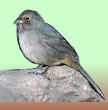 California Towhee
California Towhee- Common year-round resident. Found in most city parks and even some backyards. Usually seen on ground or low in brush. Its distinctive "chink" call may be used any time of year. Highly sedentary: mated pairs rarely stray far from their territory. Any brushy area in Golden Gate Park, Presidio, McLaren Park or around Lake Merced may have resident pair. Fall and winter it can be seen feeding with sparrow or junco flocks. Avoids open areas.
- Fox Sparrow
- A dark, spotted sparrow. Larger than other common sparrows in San Francisco. November-April. Rarely makes a sound before spring. Usually seen in small numbers in underbrush, along with other sparrows. The characteristic chicken-scratch method of feeding should be looked for. More secretive than other wintering sparrows.
- Golden-crowned Sparrow
- This slightly bigger northern cousin of the White-crowned is only here in fall and winter. They often form mixed flocks that include a pair of California Towhee, a Fox Sparrow or two, perhaps some Juncoes and a stray Lincoln or White-throated Sparrow. Golden-crowns are a certainly at Strybing Arboretum from November until March. Will give its plaintive call in fall and early spring.
- Dark-eyed Junco
- Despite the feral cats, a small population breeds in San Francisco. Often vocal during the spring and early summer. The locals are annually joined by many wintering birds from north and east. Found around Chain of Lakes and Bercut Equitation Field in Golden Gate Park. Can often be found at Inspiration Point in the Presidio as well. Sometimes flocks with sparrows and towhees.
- Tricolored Blackbird
- Probably regular fall migrant. Check the blackbird flocks at south side of Lake Merced and around the horse stable and Chain of Lakes in Golden Gate Park. September and October most likely.
- Western Meadowlark
- Regular wintering bird in open areas of Candlestick Point and Presidio. Check Crissy Field and grassy areas around the Presidio Museum. Not known to regularly breed in San Francisco but plentiful in grassy habitat within 25 miles of the city.
- Hooded Oriole
- In recent decades this southwest native has colonized central California and regularly nests where fan palms are grown. South of Letterman Hospital and at Kobbe & Upton are two breeding areas in Presidio. A pair usually breeds in Sutro Heights Park at 48th Avenue and Geary, another in palms at Dolores Park in the Mission District. Males arrive and begin singing in April. Most Hooded Orioles gone by Labor Day.
TOWHEE.NET: Harry Fuller, 820 NW 19th Street, McMinnville, OR 97128
website@towhee.net
